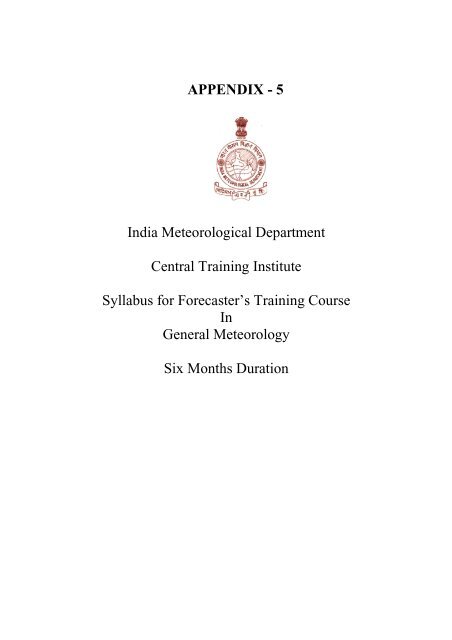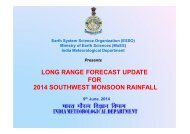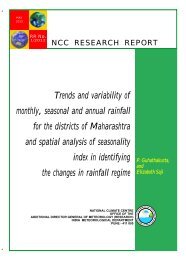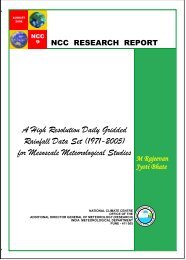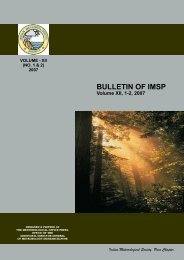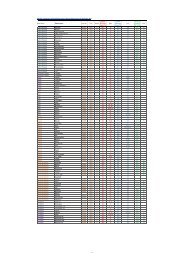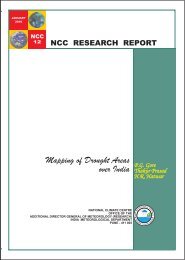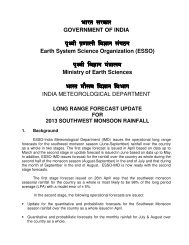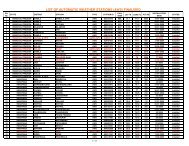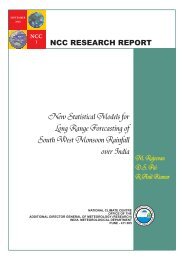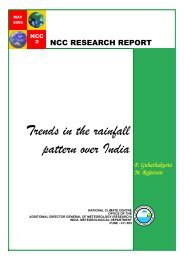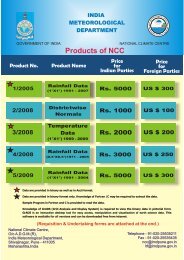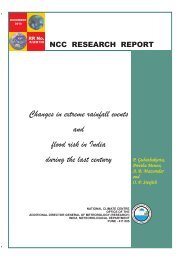5 India Meteorological Department Central Training ... - (IMD), Pune
5 India Meteorological Department Central Training ... - (IMD), Pune
5 India Meteorological Department Central Training ... - (IMD), Pune
Create successful ePaper yourself
Turn your PDF publications into a flip-book with our unique Google optimized e-Paper software.
APPENDIX - 5<strong>India</strong> <strong>Meteorological</strong> <strong>Department</strong><strong>Central</strong> <strong>Training</strong> InstituteSyllabus for Forecaster’s <strong>Training</strong> CourseInGeneral MeteorologySix Months Duration
Sr.No Subject Hour1 Dynamic Meteorology/Geophysical fluid dynamics(Theory + 60+20=80Practical)2 Numerical weather prediction (Theory + Practical)3a Physical Meteorology(Theory + Practical) 40+20=603b Physical Oceanography 304a Synoptic Meteorology (Theory and Practicals)4b Aviation (Theory and Practicals)5a Climate Science 605b Statistics (Theory+Practical) 20+30=506 Hydrometeorology 207 Satellite Meteorology(Theory + Practical) 30+25=558 Radar Meteorology 209 Computer Programming and applications 40+35=75Total 7001
Paper -1: Dynamic Meteorology/Geophysical fluid dynamicsTheory (Total Hours: 60 Hrs)• Circulation and vorticity (12 hours): Definition & Mathematical expression ofCirculation. Absolute and relative circulation. Circulation theorems. Interpretation ofterms in the circulation theorem. Application of circulation theorems.Definition ofvorticity along with its mathematical expression. Physical meaning of Curl of any vector.Components of vorticity vector. Relation between circulation and vorticity. Relativevorticity in natural co-ordinate. Explanation of curvature and shear vorticity with specificexamples. Concept of potential vorticity. Conservation of potential vorticity (conceptual)and its application.Voriticity equation in different Co-ordinates (No derivation). Physicalinterpretation of different terms. Scale analysis of vorticity equation. Application ofvorticity equation. Geostrophic vorticity.• Pressure tendency and mechanism of pressure change (2 hours): Pressure tendencyequation (No derivation): physical interpretation, in detail, of each term, representingdifferent mechanisms of pressure change. Different isobaric patterns and their movement.• Perturbation theory (1 hours): Why perturbation method has been proposed?Hypothesis in Perturbation method. To show that perturbation method can remove nonlinearityfrom governing equation.• Atmospheric Waves (9 hours): General definition of wave. Wave- amplitude,frequency, wave length, wave number. Definition & concept of Phase velocity, groupvelocity, Dispersion relation, dispersive wave, non- dispersive wave. Atmospheric waves:Rossby wave, Gravity wave (External, Internal & Inertia), Kelvin wave. Detail discussionabout their dispersion relation (No derivation), Phase speed & group velocity. Physicalinterpretations of above. Forced flow across a mountain, critical flow, sub critical flow,super critical flow, Froud number and its application.• Hydro-dynamic instability (6 hours): General definition of hydrodynamic instability.Categorization of hydrodynamic instability in different ways.Barotropic & Baroclinicinstability, their definition, analysis, criteria and examples. Brunt-Vaisalla instability:Definition & its analysis.Inertial instability: Method of analysis and instability condition.CISK: Definition and explanation.• Planetary boundary layer ( 15 hours): A brief introduction to PBL: Definition of PBL.Importance of PBL. Characteristics of PBL: the turbulent motion. Types of turbulentmotion: Convective turbulence and Mechanical turbulence. Conditions, favourable forConvective turbulence and Mechanical turbulence. Depth of PBL and its diurnal andseasonal variation at a place. Different sub layers in PBL.Boussinesq approximation andits physical interpretation. Governing equations in the PBL using Boussinesqapproximation. Reynolds averaging technique. Concepts of eddy flux, eddy fluxdivergence in detail and their importance. Governing equations for mean motion in PBL.Definition of a closed system and an open system of equation. Assumptions to make thesystem of governing equations, closed. Turbulent kinetic energy equation (No-derivation)and the physical interpretation of different terms of it. Concept of Flux Richardsonnumber. K-Theory/ Flux-gradient theory/ Similarity theory. Mixing length theory.Logarithmic vertical profile of horizontal wind in viscous sub layer using similaritytheory. Concept of roughness length and Von-Kerman constant. Vertical profile of mean2
horizontal wind in atmospheric/ oceanic Ekmann layer. Depth of Ekmann layer. Conceptof Ekmann layer pumping. Secondary circulation. Spin down. Relation between masstransport in oceanic Ekmann layer and surface wind stress. A dynamical explanation forEl-Nino and La-Nino. Convective boundary layer (CBL) or well mixed boundary layer.• Dynamical aspects of general circulation (15 hours): Energetics aspects of Generalcirculation: Definition of Atmospheric energetics. Different form of atmosphericenergies, viz., internal energy, potential energy and kinetic energy. Expressions forinternal energy. Global internal energy, global potential energy and global kinetic energyequation (Derivation not required).Detail physical interpretations of generation ofpotential energy, global internal energy and its conversion into kinetic energy. Detailphysical interpretation for generation mechanism of global kinetic energy, its conversioninto potential and internal energy and the dissipation of kinetic energy. Belt of subtropical anticyclone, the source region for global kinetic energy. Global energy equation.Dynamical explanation for the sun to be source of atmospheric energy.Equivalence ofinternal and potential energy in a stably stratified hydrostatic atmosphere. Physicalexplanation for the proportionality of I.E and P.E in hydrostatic and stably stratifiedatmosphere.Introduction to total potential energy (TPE). Concept of available potentialenergy (APE). Qualitatively comparison of APE in a region based on day-to-daycharts.Concept of zonal APE, KE, PE and eddy APE, KE, PE. Global angular momentumbalance equation. Interpretation of mountain torque, frictional torque and meridionaltransport of zonal angular momentum. Different mechanisms for meridional transport ofzonal angular momentum.Dynamic Meteorology/Geophysical fluid dynamics :PracticalsTotal hour =20• Computation of horizontal divergence and vorticity using curvature method (4 hours).• Computation of geostrophic wind and geostrophic vorticity at a point using model winddata (4 hours).• Computation of thermal wind and thermal advection (4 hours).• Solving Poison’s equation by relaxation method (4 hours).• Computation of vertical velocity using kinematic method from model wind data (4 hours)3
Numerical Weather Prediction (Theory)Paper -2 Numerical weather predictionTheory1. Theoretical aspects of NWP:History of NWP, with special reference to <strong>India</strong>n context. Hierarchy of NWP models.What is broadly understood by the term ‘NWP model’? Different components of a NWPmodel (basic concept only). Introduction to different vertical coordinate systems. Mapfactor (m).2. Numerical Methods: Different methods for solving model equations: Finite differencemethod. Implicit & semi implicit scheme. Numerical stability criterion (CFL). Spectral method.Basic concepts about spherical harmonics, Spectral representation of fields, Triangular andRhomboidal truncation.3. Data Assimilation: Basic concept of data assimilation. Different stages of data assimilationobjectiveanalysis and initialization. What is objective analysis and salient features of differentobjective analysis ,viz., Cressman techniques, OI scheme (Optimum interpolation), Statisticalspectral interpolation schemes and their comparison. What is initialization and salient features ofdifferent initialization schemes viz., Static, Dynamic, Normal mode, & Physical and theircomparison. Concept of Variational data assimilation.4. Parameterization of physical processes (10 hours): Basic concepts of sub grid scalephysical processes and their parameterization. Salient features of differentparameterization schemes and their comparison for Planetary boundary layer, Convection(Deep cumulus and shallow convection), Large scale condensation, Radiation (short wave &long wave parameterization), Cloud Radiation interaction, Dry and moist convective adjustmentprocesses, Hydrology (Bucket method).5. Basics of Operational Numerical Models: Mesoscale model, Regional Model(LAM), Global Model (mainly Medium Range Forecasting), Climate Model Ensemblemodel & Super ensemble model.6. NWP Products: Different NWP products and their interpretation. Post processing ofmodel output.Forecast verification technique and different Forecast skill scores.Forecast errors, Systematic errors. Interpretation & application of model output. ModelOutput Statistics (MOS) and their use in Short Range (1 - 3 day)weather elementsforecasting ofBasic concepts on Storm Surge modeling , Ocean State Modeling, Crop WeatherModel, Pollution Model, Aviation Hazard Modeling, Hydrological Cycles.Practical: Numerical form of Laplacian of a scalar. Computation of Laplacian of a scalarfield. Numerical method of solving Poisson equation. Graphical packages for illustration4
of NWP products. Stream function, velocity potential and vertical velocity. Numericalexperiments with NWP models (WRF & AGCM).Paper-3 Physical Meteorology & Physical Oceanography(Total Hours = 90)Section- A: Physical MeteorologyTheory (Total Hours = 40)• Thermal structure of the atmosphere; troposphere, stratosphere, mesosphere,thermosphere, and explanation of these. Basic ideas and concepts of QBO, andstratospheric warming. Tropopause breaks. ( 7 hours).• Theory of atmospheric visibility by day and night, atmospheric optics (basic ideas).Effect of air pollution on visibility. <strong>Meteorological</strong> Optical Range (MOR); concept andapplication.( 5 hours).• Cloud Physics – initial stage of condensation; curvature effect; condensation nuclei;growth of cloud droplets by diffusion and by coalescence; collection efficiency; freezingnuclei; formation of ice and snow; Precipitation, rain making experiments, weathermodification. Theories of generation of hail in thunderstorms. (8 hours).• Fair weather electrical field of the atmosphere, electrical conductivity and ionizationin the atmosphere, thunderstorm electrification, lightning discharge. (7 hours).• Air pollution: Basic ideas and concept of air pollution; sources, causes, Impact of airpollution on health, acid rain meteorological factors affecting air pollution, wind rosediagram.(7 hours).• Ozone; Ozone hole, CFC and awareness of Montreal protocol.Radar Meteorology :-Doppler Radar; basic principal and application.( 6 hours).Practical (Total Hour = 20)• Study of stability conditions for given sounding data.( 6 hours).• Determining the perceptible water vapour amount.(4 hours).• Computation of various stability Indices for prediction of thunderstorms (10 hours)Section – B: Physical Oceanography(Total hours =30)• Geographical data relating to oceans and their importance ( 2 hours).• Physical properties of sea water; T – S diagram (3 hours)• Absorption of solar radiation (2 hours)• Extinction coefficient in the sea (2 hours)5
• Air sea interaction; surface wind and current, waves, upwelling, Ekman current (4 hours)• Formation of subtropical anticyclones, ENSO & Monsoon brief ideas.( 4 hours)• Heat budget of the oceans (4 hours)• observation and collections at sea; water sampling devices, temperature measurement (4hours)• Marine pollution to be taught; its sources, causes and its impact on marine environmentbriefly. (2 hours).• Global warming and sea level rise and its importance for coastal areas, small island andmarine ecosystem, in brief. (2 hours)• Tides and Tidal energy (1 hour)Paper- 4 : Synoptic Meteorology Theory & AviationSynoptic Meteorology (Theory)1 Air masses and fronts; Production and transformation of air masses; conservationalproperties, the exchange properties and formation of air masses; air masses sources in winterand summer; Classification of air masses; types of transformation2 Fronts and frontogenesis – surfaces of discontinuity, typical structure of fronts, slope offrontal surfaces, classification of fronts, kinematic and dynamic boundary conditions,frontogenesis and frontolisis, frontogenetical fields; Principal frontal zones.3 The structure of extratropical cyclones and anticyclones – cyclone model; life cycle ofcyclones; Fronts and weather; Occlusions; thermal structure of cyclones; cyclone family;theory of cyclone development; a forecasting guides; example of cyclone development;anticyclones; cut off cyclones and anticyclones; Blocking; index cycle.4 Tropical Cyclones – life cycle; surface and upper air structure; pressure; temperature, wind,humidity and cloud fields; Energy aspects, formation of tropical storms, theories offormation, intensification and movement of tropical storms5 The Jet –streams – polar front jet stream – subtropical jet stream, polar night jet stream,Easterly jet stream, Characteristics features of the various Jet Streams, theories of formation,weather development, cloud and clear air turbulence.6 Winter season – Western disturbances, cold waves, fog and jet streams, disturbance from theeast, fronts in the <strong>India</strong>n region6
7 Hot weather season – Norwesters; Dust storms and dust raising winds, thunderstorms, hailstorms, tornadoes, heat waves, Jet streams, cyclonic depression and storms in the <strong>India</strong>n seas8 The southwest monsoon season: - Monsoon onset, strong monsoon, weak monsoon, revivalof the monsoon, monsoon depressions, heavy rainfall, easterly jet stream, influence of extratropical systems, Chinese weather systems, effect of typhoons and other systems from theeast, withdrawal of the monsoon9 The northeast monsoon season – strong and weak northeast monsoon, depressions and stormsin the <strong>India</strong>n seas, forecasting their information, movement, recurvature, jet streams.10 Double equatorial troughs – depiction of synoptic features in the equatorial regions indifferent seasons for the year.• Aviation:• Organization of the <strong>IMD</strong>; World <strong>Meteorological</strong> Organization; and International CivilAviation Organization.• Aviation Procedures: <strong>Meteorological</strong> organization for aviation in <strong>India</strong>; Altimeter settingprocedures; briefing and documentation, procedures; <strong>Meteorological</strong> services providedto airlines; Area <strong>Meteorological</strong> Watch; Aviation Climatological Publications;<strong>Meteorological</strong> requirements of turbine engine aircraft; Elements of air navigation andpressure pattern flying.• Decoding of flight, root and aerodrome forecasts on relevant forms.• Issue of routine aviation forecasts such as area forecast, Route forecast, Flight forecast,Terminal forecast, Airfield warnings etc.o <strong>Meteorological</strong> broadcasts for aeronautical purposes. Air traffic services;altimeter setting procedures; Metrological Organization for Aviation in <strong>India</strong>:o Display in <strong>Meteorological</strong> Offices; Aviation Climatological publications. Differenttypes of aircraft (Pistonprop: turboprop; Jet etc.) and their meteorologicalrequirements; Publications of Civil Aviation <strong>Department</strong>. Elements of AirNavigationo Effects of weather on aircraft flights; Air accidents and their InvestigationsVVIP/VIP flights.7
Study of analyzed weather central charts for issue of TAF, Trend, Flight / Routeforecasts, SIGMET etc. Preparation of Significant weather charts Familiarization with numerical model output products and their use Writing of aviation forecasts such as area forecast, Route forecast, Flight forecast,Terminal forecast, Airfield warnings etc.• Preparation of flight forecast, two for each season. Preparation of TREND forecast fordeterioration and improvement in respect of each element. Formats and elements indifferent types of forecasts/warning (both aviation and non-aviation), Decoding of flight,route, and aerodrome forecast on relevant forms.Practical:Synoptic Meteorology1. Analysis and issue of inference and forecasts for a chart sequence for tropical cyclone, Satelliteand RADAR pictures should also be used along with the chart sequence.2. Analysis and issue of inference and forecasts for a chart sequence for a monsoon depression3. Analysis and issue of inference and forecasts of a widespread thunderstorm activity case4. Analysis and issue of inference and forecasts for a chart sequence in a western disturbance case5. Analysis and issue of inference and forecasts in an onset and advance of monsoon case6. Analysis of extended charts – surface and upper air of January and July cases and their 24 hoursprognosisAviation Meteorology1. Study of analyzed weather central charts for issue of TAF, Trend, Flight / Route forecasts,SIGMET etc.2. Preparation of Significant weather charts3. Familiarization with numerical model output products and their use4. Preparation of significant weather charts5. Familiarization with Numerical Model output products and their use in Aviation.8
Paper-5 : Climate Science & StatisticsTheory (Total: 110 hours)Part-A: Climate Science (Total Hour = 60)Synoptic Climatology (5 hours)• Extra-tropical – Air mass climatology - January and July; Geographical distribution ofFronts, Frontal zones - Extra-tropical cyclones – frequency, regions of blocking andcyclogenesis.• Climates of other regions in brief (3 hours)Asia, Africa, North America, South America, Europe, Australia, Arctic and Antarctic.• Angular momentum cycle ( 3 hours)• Water Cycle ( 4 hours)• Energetics and the Ocean-Atmosphere Heat Engine (6 hours)• Variability in the climate system (13hours)- Interannual and interdecadal variability (1 hours)- Monsoon (southwest and northeast) Variability, diurnal, intraseasonal,Interannual, decadal, long term trends, Teleconnection patterns (5 hours)- El Nino/ Southern Oscillation, Climatology, Dynamics and prediction, links withglobal climate (5 hours)- North Atlantic Oscillation, North Pacific Oscillations, NH TeleconnectionPatterns (1hours)- <strong>India</strong>n Ocean Dipole, statistics, dynamics and links with global climate (1hours)• Climate modeling and prediction : Mathematical simulation of climate, modelsimulations of mean climate, Fundamentals and methods of long range forecasting,<strong>IMD</strong>’s long range forecast models, Dynamical models for long range forecasts, Skill oflong range forecasts (7 hours)• Science of Climate Change : Basics of Climate Change (science), Climate Feedbacks(water vapour, cloud, oceans, snow and ice), Observed climate change over <strong>India</strong> andglobe, Future climate projections, IPCC report results (8 hours)9
• Basic ideas of Agricultural meteorology including energy and water budget of crops, andcrop yield relationship with weather elements, crop weather calendar (3hours)• Micrometeorology - Definition and generation of microclimates, elements ofmicroclimatology (2hours)• Basic ideas on Bioclimatology and Applied Climatology (2 hours)• Paleo-climatalogy (4 hours)Part-B: StatisticsTheory (Total hours = 20)• Elements of sampling, tests of significance; Null Hypothesis; Students 't’ test;contingency tables Chi-square test• Time series and harmonic analysis• Analysis of variance ANOVA/ MANOVA)• Multivariate Regression Analysis• Cluster and Factor Analysiso Testing of null hypothesiso Time series analysiso Trend analysisPractical (Total Hour = 30)o Cross correlation & Auto correlation with different lago Harmonic analysiso Multivariate regression analysisPaper -6: Hydrometeorology (Total Hours = 20)o Network design for a river basin (1 hour)o Estimation of average rainfall in a basin (2 hours)o QPF(1 HOUR)o Hydrological cycle (1 hour)o Estimation of Design Storm (2 hours)o Hydro met Disasters , Flood and Drought (4 hours)o Rainfall Runoff Relation (3 hours)o Mountain Meteorology (2 hours)10
o Snow Hydrology (2 hours)o Developments in Water Resources (2 hours)Paper-7 Satellite MeteorologyTheory: Total Hours = 30• Remote Sensing, Principles of Remote Sensing, Application in Meteorology, Introduction toSatellite Meteorology including Orbital Mechanics. (4 Hours).• <strong>Meteorological</strong> Satellites, Polar Orbiting, Geostationary satellites, Current and futuremeteorological satellites of the world. Payloads on <strong>Meteorological</strong> Satellites, NOAA,INSAT -3D, Metop. (3 Hours).• Processing of data from Imagers, INSAT <strong>Meteorological</strong> Data Processing System(<strong>IMD</strong>PS). Generation of images in various channels. Retrievals of meteorologicalproducts from the imager data including water vapor. Atmospheric motion vectors, SeaSurface Temperature and Upper Troposphere Humidity (UTH), Outgoing Long waveRadiation (OLR), Quantitative Precipitation Estimates (QPE), Rainfall, Fog, Minoratmospheric constituents/aerosols/ Fire /smoke, Enhancement techniques, Gray scales,Pseudo Color Images. (6 Hours).• Principles of Sounding, Processing of data from Infrared and Microwave Sounders.Retrieval of products from sounder, Vertical temperature, humidity and ozone profiles. (5Hours).• Interpretation of Satellite images of various channels and identification of typical cloudsand weather systems from cloud imageries, use of various satellite derived products,satellite Bulletin and its interpretation. Tropical cyclone, its identification and gradingusing Dvorak’s technique. (6 Hours).• Automatic Weather Stations (AWS), full technical details Digital Cyclone WarningDissemination System (DCWDS), Digital <strong>Meteorological</strong> Data Dissemination (DMDD).(3 Hours).• Hardware details of INSAT <strong>Meteorological</strong> Data Processing System (<strong>IMD</strong>PS) includingEarth Station. GPS technique for Integrated Precipitable Water Vapor (IPWV)measurement. (3 Hours)Practical :Total Hours =25• Study of typical satellite pictures from both geostationary and polar orbiting satellites.Identification of different types of clouds and weather systems from Satellite images. (8Hours).11
• Issue of Satellite bulletins. (2 Hours).• Assessment of T-number of Cyclone from satellite images using Dvorak’s technique(form to be filled up by the trainees). (8 Hours).• Practical Exercises on Use of Satellite derived products for weather analysis andforecasting, generation of products and posting on website. (7Hours)Paper -8 Radar MeteorologyTotal Hours = 20Radar principles.Doppler Radar, Wind profiler, MST Radar, LIDARSScattering of microwaves by precipitation / precipitating particles. Scatteringsphere, Scattering by rain and ice crystals.by aMinimum detectable power, receiver noise, radar equation for a point target, part playedby various parameters in the radar equation. Radar equation for an extended target.Practical importance of radar set constants and the radar cross section. Effect of wavelength,wave lengths commonly used. Types of scans used in weather radar, their merits.Classification of radar echoes.Convective and stratiform types, bright band echo from lightening, tornadoes, squalllines.Study of severe storms and cyclones, quantitative measurement of ZR & M and their corelation.Measurement of rate and amount of precipitation, effect of circular polarization,use of circular polarization in weather radar research, non-precipitating / precipitationechoes, super-refraction, limitations of weather radar.Elementary ideas of cloud physics. Drop size distribution in various types of rain.Relation between drop size, terminal velocity, rate of rain fall and radar echo intensity.Study of Disdrometer and its application.Doppler radarDoppler radar principles and its limitations. Doppler principle of velocity measurement,unambiguous velocity and range. Doppler dilemma. Spectrum width. Introduction toDWR (Physical visualisation/inspection), RAINBOW workstation.Principles of dual polarized doppler radar. Advantages over conventional doppler radartechniques.Doppler radar base products and derived products.1. Introduction to reflectivity products and their utilization. PPI, RHI, CAPPI,PCAPPI, MAX, VIL, HHW, EBASE, ETOP, VCUT.2. Hydrological products SRI, VIL, PAC, PRT.12
3. Velocity products, PPI_V, VVP-2, UWT_2, Max_V and their utility in weatherforecasting. Horizontal shear, vertical shear, AZ shear, EL shear.4. Spectrum width products.Visit to Doppler weather radar installation.Products generation using raw data of a doppler radar.Application of doppler radar in weather forecasting.Nowcasting techniques using DWR.Use of DWR products in ACWC forecasting, aviation safety.Experience of some recorded weather events using DWR.Paper -9 Computer Programming and applications(Total : 40 hours)Computer Programming / Applications (including practicals)• Fortran-77/90 Programming• Introduction to Numerical Analysis - Successive approximations – Taylor series -Propagation of Errors - Solution of Algebraic / Transcendental equations (Regular-Falsi.Newton-Raphson methods etc.) - Interpolation (Newton’s Lagrange's schemes) -Numerical integration (Simpson's. Weddle's formulae, etc.)• Matrices - Solution of Simultaneous Equations (Matrix Inversion. Iterative andRelaxation methods, etc.) - Numerical solution of ordinary differential equations (Euler,Predictor – Corrector, Runge Kutta methods) - Numerical solution of partial differentialequations (Iterative and Relaxation methods) - Finite differencing schemes -Computational stability / instability in meteorological problems.• Numerical Analysis: Practicals, Fortran• Statistical Package (SPSS /SYSTAT/ R Software ) for advanced statistical applications***********************************************************13


